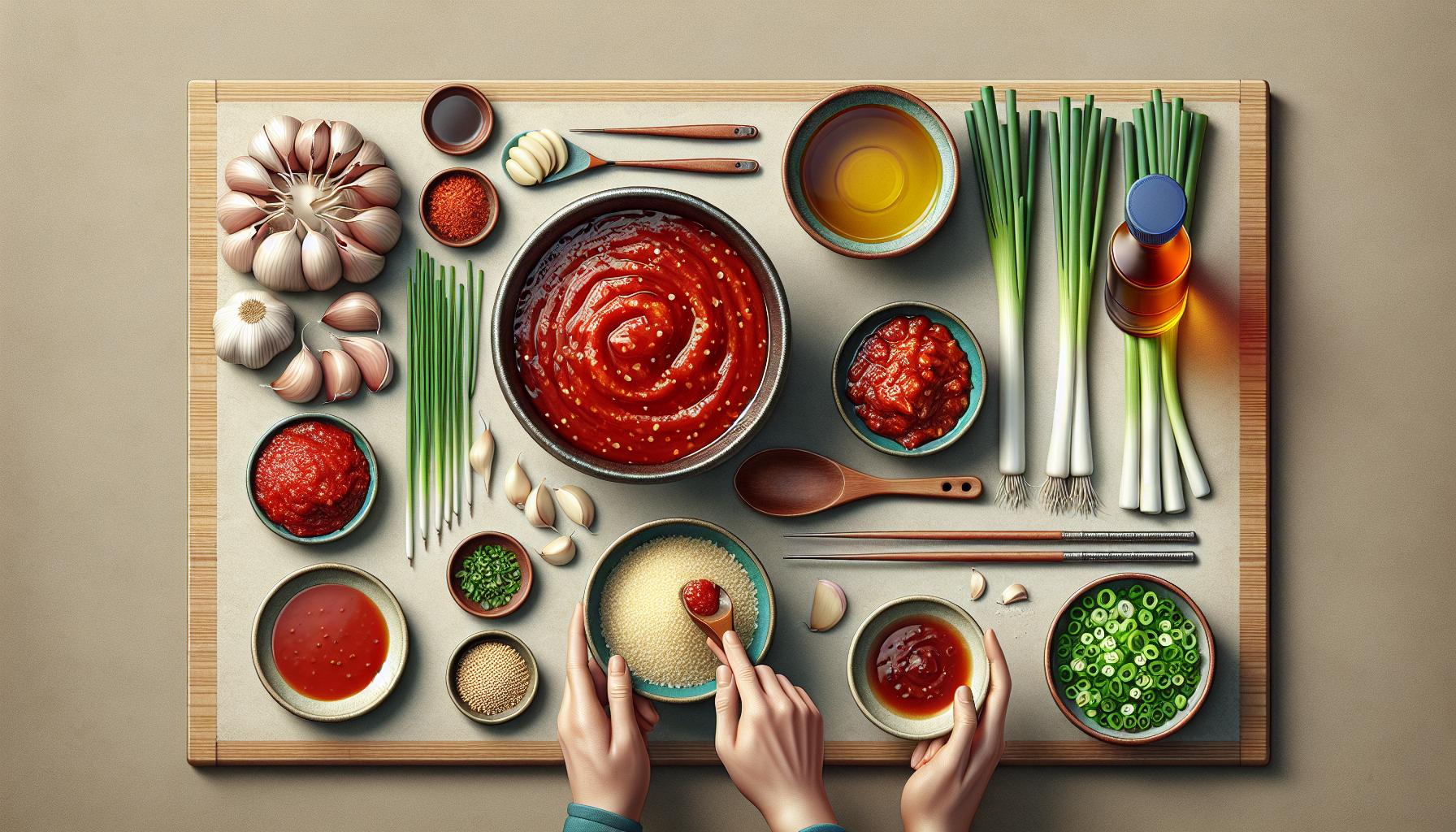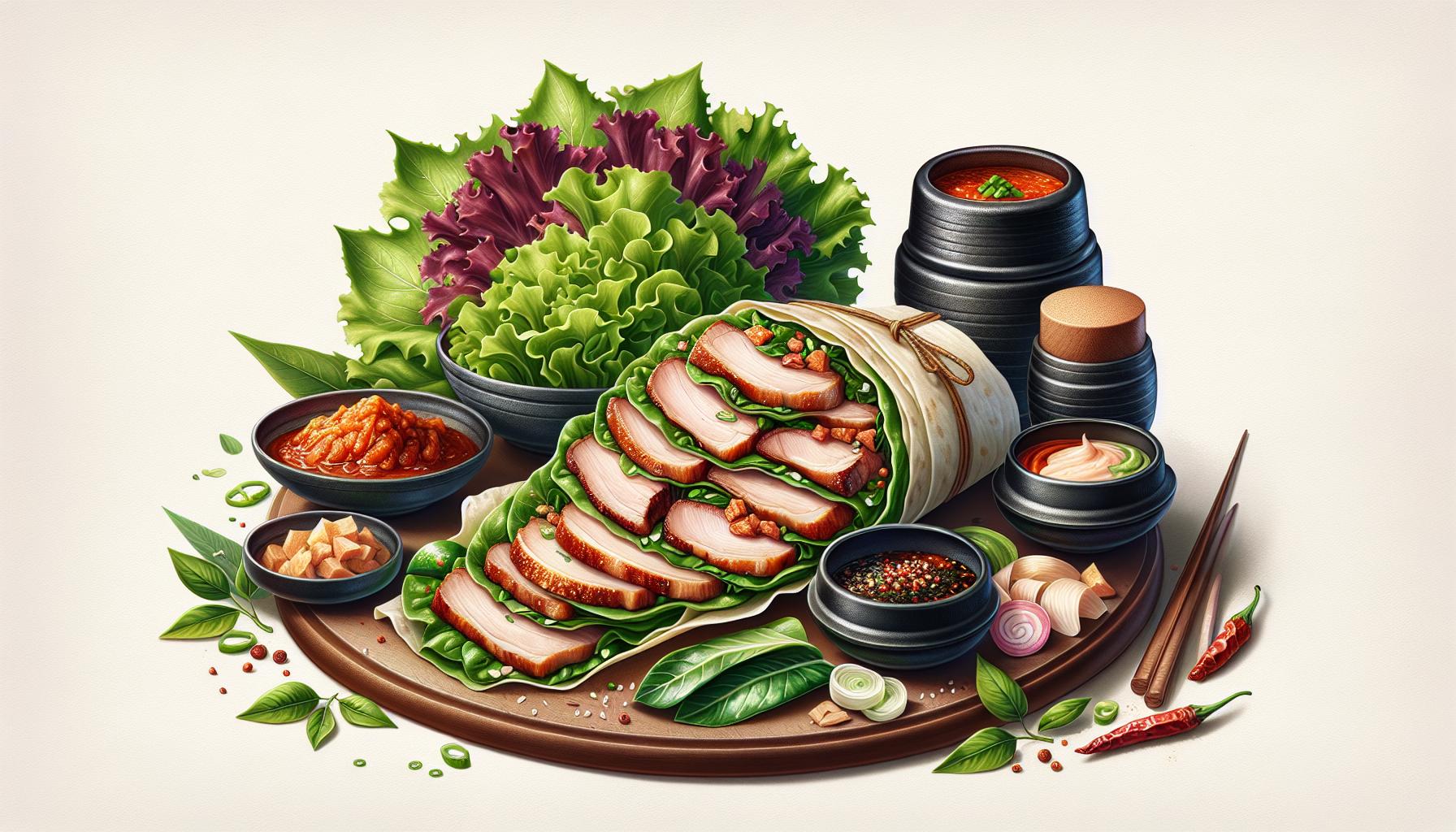Ingredients for Homemade Bossam
Now that you understand what homemade Bossam is all about, let’s dive into the specifics you’ll need to prepare this delightful treat. Don’t worry about massive shop lists; the compilation focuses on essentials while ensuring a tantalizing taste.
Your main component, of course, is pork belly. A 2-pound slab is ideal for this recipe. It offers the perfect blend of lean meat and fat, giving your Bossam a tasty and tender quality.
You’ll also need fresh veggies to complement the pork. Two heads of napa cabbage, a bunch of lettuce, and perilla leaves to be precise. They add an earthy balance to the rich flavors of the meat.
Spices and sauces are the secret behind Bossam’s robust profile. You’ll need two tablespoons of doenjang (Korean soybean paste), one tablespoon of gochujang (Korean chili paste), two cloves of garlic, one onion, and three green onions. To add a unique twist, consider adding a teaspoon of mustard; it’s unconventional, but it gives an exciting kick to the sauce.
The time to underpin the importance of salt and sugar in your Bossam. Sprinkle about two tablespoons of coarse sea salt and one tablespoon of sugar on the pork belly before boiling. Salt helps tenderize the meat whilst sugar balances the saltiness, enhancing the meat’s inherent flavors.
| Ingredients | Quantity |
|---|---|
| Pork belly | 2 pounds |
| Napa cabbage | 2 heads |
| Lettuce | 1 bunch |
| Perilla leaves | 1 bunch |
| Doenjang (Korean Soybean Paste) | 2 tablespoons |
| Gochujang (Korean Chili Paste) | 1 tablespoon |
| Garlic | 2 cloves |
| Onion | 1 piece |
| Green onions | 3 pieces |
| Mustard | 1 teaspoon |
| Coarse sea salt | 2 tablespoons |
| Sugar | 1 tablespoon |
Armed with these ingredients, your Bossam creation journey awaits. The assembly and cooking processes might be a challenge initially. Yet, with practice, you’ll become more proficient, invariably enhancing the flavor and authenticity of your homemade Bossam.
Step-by-step Cooking Instructions

Step 1 – The Pork Belly:
Begin with the pork belly. To enhance the flavor, season it generously with coarse sea salt and sugar. Allow it to sit for about 20 mins. Next, you’ll need to boil the pork belly.
In a large pot add:
- Pork belly
- 1 Onion (whole)
- 2 Green onions (whole)
- 6 cloves of Garlic
Boil the assembly for up to 2 hours. Ensure the pork belly is tender and succulent.
Step 2 – The Wraps:
As the pork belly is simmering, prepare the wraps. Traditional Bossam is served with napa cabbage and lettuce wraps. Optionally, you can also include perilla leaves for an added kick of flavor. Rinse and drain these leaves well.
Step 3 – The Ssamjang Sauce:
To make the ssamjang, the sauce that really brings Bossam to life, you’ll need:
- 1 tablespoon Doenjang
- 1 teaspoon Gochujang
- 1 clove of Garlic
- 1 Green onion
Grind garlic and onion finely. Mix these with Doenjang and Gochujang to form the sauce.
Step 4 – Set to Serve:
Arrange the boiled pork belly, wraps, and ssamjang attractively on a serving dish. Encourage guests to assemble their Bossam wraps according to taste. But don’t forget the joy of Bossam is in its DIY nature. Keep the ingredients in separate dishes, allowing guests to make their own flavour combinations.
Enjoy the Authentic Taste of Homemade Bossam! With the right ingredients and these simple steps, you’ll bring a little piece of Korea to your kitchen.
| Ingredients | Quantity |
|---|---|
| Pork belly | 1.5 kg |
| Coarse sea salt | 2 tbsp |
| Sugar | 2 tbsp |
| Onion | 1 whole |
| Green Onions | 2 whole |
| Garlic | 6 cloves |
| Napa Cabbage | 8 leaves |
| Lettuce | 8 leaves |
| Perilla leaves | Optional |
| Doenjang | 1 tbsp |
| Gochujang | 1 tsp |
Making the Spicy, Tangy Sauce

A homemade Bossam boiled pork wrap isn’t complete without its vibrant partner – the spicy, tangy ssamjang sauce. Your sauce serves as the main seasoning in this dish. Hence, it’s essential to get it right.
Let’s walk you through the steps. To begin with, you’re going to need some specific ingredients. Gather up the Doenjang, Gochujang, finely chopped garlic, and green onions. If you’re new to Korean cuisine, Doenjang is a type of fermented soybean paste, while Gochujang is a famous red chili paste.
Here’s a little tip. Throw in a splash of sesame oil for that extra depth of flavor. Not a common move in traditional recipes but trust us; your taste buds will thank you!
| Ingredient | Amount |
|---|---|
| Doenjang | 2 tablespoons |
| Gochujang | 1 tablespoon |
| Garlic | 1 clove, fine |
| Green Onion | 2 tablespoons |
| Sesame Oil | 1 teaspoon |
Your first step is to mix both the Doenjang and the Gochujang in a bowl until everything’s well combined. A not-so-secret secret? Blend it well. The better you mix, the smoother your sauce becomes!
Next, add in your finely chopped garlic along with the green onions you’ve prepared. Mix it all together until the ingredients blend seamlessly.
Your final step involves that surprise player we mentioned earlier – the sesame oil. Drizzle it in, giving everything one last good stir. That’s it – you’ve just made your own batch of spicy, tangy ssamjang sauce!
It’s crucial to remember that this sauce isn’t just about following steps. It’s about tasting and tweaking. Feel free to adjust the amounts of Doenjang, Gochujang, garlic, and green onions to suit your palate. Everyone’s taste buds are different – make it your own!
When you’re ready to serve, add your new creation to the serving dish alongside the boiled pork belly and wraps. Your guests are sure to be impressed.
Assembling the Pork Wraps

The magic of Bossam lies not just in its zesty ssamjang sauce but also in its unique wrapping technique. Let’s dive into this exhilarating process to get the perfect bite of your homemade Bossam dish.
Grab a lettuce leaf—it’s the basic building block of your wrap. Layer a perilla leaf on top if you want an added fragrant kick.
Now for the meat of the matter! Get a slice of your beautifully boiled pork belly—cooked with all the delicate seasoning as previously mentioned—and place it gently on your leafy base. How thick should your slice be? It’s all up to your personal preference!
Then, slather on your homemade ssamjang, the piquant paste that’ll ensure your taste buds embark on an exciting journey. Remember not to go overboard; the sauce is potent, and a little can go a long way.
Add a sliver of raw garlic or a slice of jalapeno if you seek an adventurous endeavor. It gives the Bossam wrap an unexpected fiery twist to the otherwise savory ensemble. This proves especially popular among spicy food lovers.
Once you’ve got all your components in place, it’s time for the grand wrap up. Fold over the lettuce around the fixings in the center. Do not fret if your first wrap isn’t perfect; it’s part of the journey.
Inside the wrap, the glutinous rice can also play a vital role. A spoonful of steamed white rice adds a carb-count and can help in balancing the bold flavors.
Serving and Enjoying Your Bossam

Now that you’ve assembled your Bossam wraps, it’s time to delve into the best part — serving and enjoying them. This isn’t just about devouring that succulent boiled pork belly nestled in a lettuce wrap. It’s about basking in the experience, appreciating the balance of bold flavors, and relishing the satisfaction of a homemade dish.
The secret to enjoying Bossam wraps lies in how you eat them. Start by ensuring you’ve got a good grasp on the wrap. Remember, it may not be perfect but it holds the journey of your effort, making it all the more delicious. Hold it gracefully and take that first bite. Allow the various ingredients to burst forth, the pork belly, the potent ssamjang sauce, perhaps the sharp kick of the raw garlic or jalapeno. Each mouthful is a mélange of flavors, a testament to the art of Bossam.
Don’t agree to the idea of eating alone. The essence of Bossam lies in its inherent nature as a shared meal. Invite friends or family to join, bringing more joy and camaraderie into the experience. Compare notes on the flavors, toast to your success, and build memories around the dining table.
Remember, eating Bossam is much more than consuming a meal. It’s an interactive food experience where each bite tells a story. So sit back, enjoy your homemade Bossam, and appreciate the intricate dance of flavors on your palate.
Nutrition is a key part of any recipe, and Bossam is no different. Here’s a basic run-down of what you can expect in each serving:
| Nutrition | Amount |
|---|---|
| Calories | 200 |
| Carbs | 5g |
| Protein | 10g |
| Fat | 15g |
While these numbers can vary based on ingredient proportions, they provide a basic understanding of what this flavorful dish offers.
Also, be aware that although this table shows the nutritional content, Bossam shines in its role as a soulful, satisfying, and communal food experience. Enjoying this meal thus stretches beyond the realms of nutrition, into feelings of satisfaction and shared happiness.
Keep in mind that Bossam is not just a dish, but an experience. Let the journey of creating, serving, and savoring it bring joy and deliciousness into your life.
Conclusion
So there you have it – the joy of Bossam boiled pork wraps isn’t just in the eating. It’s in the making, the sharing, and the savoring. It’s about the grace of holding the wrap, the explosion of flavors in each bite, and the happiness of sharing it with your loved ones. It’s not just about the nutritional value, but the satisfaction and shared joy it brings. Bossam is more than just a dish, it’s an experience. It’s a celebration of taste, of togetherness, and of all things delicious. So why not invite your friends or family over and partake in the Bossam experience? After all, nothing beats the taste of homemade Bossam wraps. So go ahead, take a bite, and let the flavors take you on a culinary journey.

